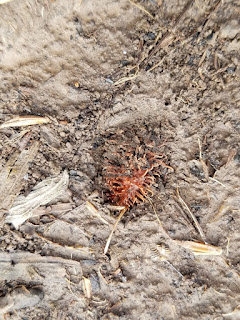It was a windy day when he planted the Road Field for us.
Given the hardened furrows, planting had to be done north-south. Every return trip meant a gale-force wind in his face, with a barrage of debris.
But he persisted until the entire field was planted with 11 species of native forbs and 1 native grass.
Al used his special native-seed drills so the seeds wouldn't be pushed too far down.
Ron rakes in some native seed. Deci stands by, ready
to help. March 22, 2017
|
For the next several days, Ron and I planted some species by hand, raking the surface, then stamping the seeds into good contact with the soil.
 |
| The seed of wild licorice (Glycyrrhiza lepidota), planted March 22, 2017. The seeds were hand-collected by Iralee Barnard. |
Here's a wild licorice seed pressed into the ground.
Licorice seeds were hand-collected by Iralee Barnard.
The 30-acre Road Field has been in crops for 150 years.
That was a long time to be constricted by humans and their insistence that fields should not be anything but monocultures of annual crops.
Last year the Road Field was allowed to go fallow, and so it began its journey back toward self-expression. We gave it a headstart with the seeds of native species that could well have lived in the bottomground before the settlers came.
As we did with the Creek Field, we used a forbs-first strategy. Because grasses can push out forbs in restorations, we want the forbs to get established before native grasses come in. We made one exception for Eastern Gamagrass, as a concession to the need to have at least a small grass-defense against weeds--and also a concession to the sheer beauty and magnificence of Eastern Gamagrass.
This is what we planted on March 19-22, 2017:
Bee Balm Monarda fistulosa
Black Eyed Susan Rudbekia hirta
Canada Milkvetch Astragalus canadensis
Compass Plant Silphium laciniatum
Eastern Gamagrass Tripsacum dactyloides
False Sunflower Heliopsis helianthoides
Foxglove Penstemon Penstemon digitalis
Golden Alexanders Zizia aurea
Indian Blanket Gaillardia pulchella
Plains Coreopsis Coreopsis tinctoria
Purple Coneflower Echinacea purpurea
Wild Licorice Glycyrrhiza lepidota
But if our experience with the Creek Field is any indicator, many other species will volunteer.
Who knows what will grow and prosper? Who knows what the Road Field will make of itself?




No comments:
Post a Comment